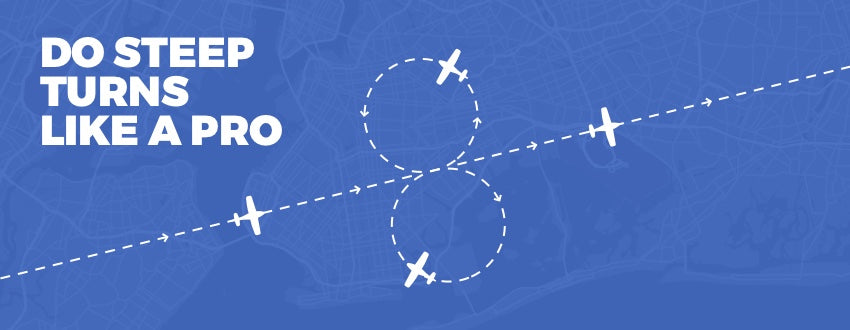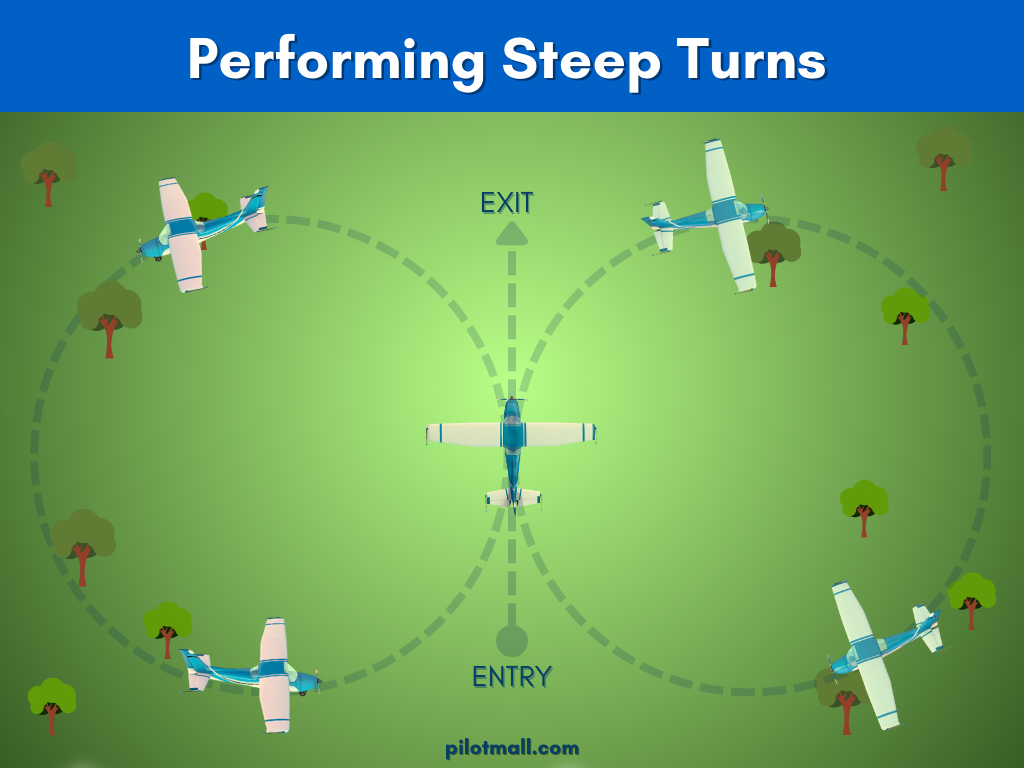Conquer Steep Turns and Rule the Skies (Step by Step)
Steeps turns require a lot of your attention and plenty of practice. During a steep turn, you must split your attention both inside and outside the aircraft while maintaining strict flight parameters.

Featured Pilot Gear
Browse our selection of high-quality pilot supplies! Your purchase directly supports our small business and helps us continue sharing valuable aviation content.

Understand a Steep Turn Procedure
Steeps turns require a lot of your attention and plenty of practice. During a steep turn, you must split your attention both inside and outside the aircraft while maintaining strict flight parameters. Steep turns are a maneuver that can help pilots to grasp the higher G forces they can experience during a turn.
There is no doubt that practicing steep turns increases pilot proficiency, so let’s explore what this is all about and make you a better pilot.
Know the standards
A steep turn is defined as:
- A 360° turn at 45 degrees bank angle while maintaining +/- 5°
During a steep turn:
- Monitor any altitude deviations. Your altitude must be maintained at +/- 100 feet
- Hold your pitch attitude
- Your airspeed must be within 10 knots
- Roll into a 45 degrees into the left or right
- Your roll out must remain within 10° of your entry heading
- Rely on your flight instruments during a steep turn
Tips and tricks
Before we get into the step-by-step guide to executing a steep turn procedure, let’s go over some basic things you can do to ensure you pull off this maneuver as a pro. It also helps to watch a steep turn training guide that explains the fundamentals.
Set yourself up for success
Prior to executing any flight maneuver, it helps to have the aircraft set up and stable. That is, let’s ensure you are trimmed out and flying straight and level. It’s simply adding more to your plate if you are already starting off slightly nose up or down and either decreasing or increasing airspeed.
Airspeed Control
Having your speed, heading and altitude all trimmed and where you want it before you start will set you up for success. If possible, start your turn on a cardinal. It’s easier to make out on the heading indicator.
Practice Makes Perfect
Practice the steep turn maneuver often. Know the power settings and adjustments that are needed both going into and coming out of your turn. With practice comes muscle memory. Your hand will begin to know the right feel of how much push and pull on the throttle you require to perform the maneuver.
Knowing and remembering what the nose attitude looks like while in a 45° turn makes staying in the turn within the limits that you will tested on much easier. Know where that spot is on the horizon and its relationship to the cowling for both the left and right turns, then create that picture in your mind and keep it there.
When performing a steep turn later, you’ll be able to come very close to that 45° mark simply by looking outside the aircraft and recalling what it looks like in comparison to the horizon line and the engine cowling because you practiced it and remember what it looks like.
A good rule of thumb is to remember that your flight instruments are your most valuable tool. Keep up your scan and keep an eye on your attitude indicator for your angle of bank. You'll need to perform this maneuver to meet up to the airman certification standards.

Flight control inputs during steep turns: small corrections are the key here
- Minor corrections for pitch are done with elevator.
- Reduce bank angle to correct for decreasing altitude.
- Slightly increase bank angle if altitude is increasing.
- Scan instruments and spot trends.
- Remember to step on the rudder during your rollout.
- Consider load factors
The Steep Turn, Step by Step:
- Perform a clearing turn. (Always, always, always do a visual scan of the horizon and clear the airspace prior to any maneuvers or turns. Failure to do so has been a cause of many in-flight accidents).
- Pick an entry heading or note your current heading (Preferably a cardinal heading).
- Look outside the cockpit and select a reference point or landmark on or about the same heading. (This gives you a visual clue prior to rolling out).
- Roll into a 45 degrees bank angle (Either to the left or right).
- Pull the nose up (As needed to maintain proper attitude and altitude).
- Adjust power when necessary and set your trim (will be slightly nose up).
- Apply opposite aileron (Steep turns require opposite aileron input to counter the overbanking tendency of the aircraft).
- Select that point on aircraft cowling that gives you the correct sight picture for your steep turn.
- Start your scan, outside and inside the aircraft.
- Keep the correct pitch attitude with elevator control.
- Maintain +/- 100’ altitude during your turn.
- Maintain +/- 10 knots.
- Maintain your 45 degrees turn +/- 5°.
- Start your rollout within about 20 degree bank (for steep turns) of your original heading.
- Adjust power (decrease) if necessary.
- Decrease any nose up trim if you added it.
- Ensure wings are level as you complete your roll out to your original heading. Your roll out must remain within 10° of your entry heading.
- Trim for straight and level flight.
Other Considerations
Overbanking Tendency
An overbanking tendency in aviation occurs when the aircraft's bank angle increases beyond the recommended limit, potentially leading to a loss of control. Excessive bank angles can result in significantly increased control forces and decreased aircraft stability.
To prevent the overbanking tendency, a rule of thumb in aviation is to avoid exceeding the airplane's design maneuvering speed (VA) during aggressive maneuvers or steep turns.
This guideline helps maintain the aircraft's maneuverability while keeping control forces manageable and ensuring safe flight operations. Properly managing bank angles is crucial for maintaining aircraft stability and safety in the skies.
Adverse Yaw
When performing steep turn maneuvers you will need to watch out for adverse yaw. Adverse yaw is the tendency of a fixed wing aircraft to yaw in the opposite direction as you roll into a banked turn. If you roll the plane to the right, it will have an automatic tendency to make an unintended yawing motion to the left and vice versa. You can read more about adverse yaw in our guide.
Remember
Steep turns, characterized by a significant bank angle or angle of bank, are nothing to fear. They will require more of your attention because of the associated load factors and the potential for overbanking tendencies. It's important to give them the attention they deserve during your performance review, particularly as they are a crucial skill evaluated in the airman certification standards.
To master steep turns, practice them more often and remember the tips and tricks that will help you become more proficient. One rule of thumb is to aim for a specific degree bank angle while keeping your airspeed under control. Maintaining wings level and managing power effectively are key aspects of executing a successful steep turn without altitude deviations.
Make sure to focus on your altitude, as well as power management during the maneuver. With dedication to honing your skills, you'll be able to nail those steep turns like a pro!

|
Gleim Private Pilot Flight ManeuversMinimize the learning curves common to flight training with Gleim's Private Flight Training Maneuvers and Practical Test Prep. This comprehensive guide reveals the strategies and tips to help you master the maneuvers for the Private Pilot license. |
Want to learn about more maneuvers?
Our guides are designed to help student pilots become professional pilots and for private pilots to brush up on their knowledge and skills.
-
How To Fly Turns Around A Point (Complete Guide + Lesson Plan)
-
The Chandelle Maneuver: What it is and Why You Should Learn to Fly it
Did you find this article helpful?
Do you think we missed anything important? Let us know in the comments below!









